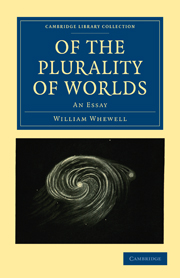Book contents
- Frontmatter
- Preface
- Contents
- CHAPTER I ASTRONOMICAL Discoveries
- CHAPTER II Astronomical Objection to Religion
- CHAPTER III The Answer from the Microscope
- CHAPTER IV Further Statement of the Difficulty
- CHAPTER V Geology
- CHAPTER VI The Argument from Geology
- CHAPTER VII The Nebulsæ
- CHAPTER VIII The Fixed Stars
- CHAPTER IX The Planets
- CHAPTER X Theory of the Solar System
- CHAPTER XI The Argument from Design
- CHAPTER XII The Unity of the World
- CHAPTER XIII The Future
CHAPTER VI - The Argument from Geology
Published online by Cambridge University Press: 05 October 2010
- Frontmatter
- Preface
- Contents
- CHAPTER I ASTRONOMICAL Discoveries
- CHAPTER II Astronomical Objection to Religion
- CHAPTER III The Answer from the Microscope
- CHAPTER IV Further Statement of the Difficulty
- CHAPTER V Geology
- CHAPTER VI The Argument from Geology
- CHAPTER VII The Nebulsæ
- CHAPTER VIII The Fixed Stars
- CHAPTER IX The Planets
- CHAPTER X Theory of the Solar System
- CHAPTER XI The Argument from Design
- CHAPTER XII The Unity of the World
- CHAPTER XIII The Future
Summary
I have endeavoured to explain that, according to the discoveries of geologists, the masses of which the surface of the earth is composed, exhibit indisputable evidence that, at different successive periods, the land and the waters which occupy it, have been inhabited by successive races of plants and animals; which, when taken in large groups, according to the ascending or descending order of the strata, consist of species different from those above and below them. Many of these groups of species are of forms so different from any living things which now exist, as to give to the life of those ancient periods an aspect strangely diverse from that which life now displays, and to transfer us, in thought, to a creation remote in its predominant forms from that among which we live, I have shewn also, that the life and successive generations of these groups of species, and the events by which the rocks which contain these remains have been brought into their present situation and condition, must have occupied immense intervals of time;—intervals so large as to deserve to be compared, in their numerical expression, with the intervals of space which separate the planets and stars from each other. It has been seen, also, that the best geologists and natural historians have not been able to devise any hypothesis to account for the successive introduction of these new species into the earth's population; except the exercise of a series of acts of creation, by which they have been brought into being; either in groups at once, or in a perpetual succession of one or a few species, which the course of long intervals of time might accumulate into groups of species.
- Type
- Chapter
- Information
- Of the Plurality of WorldsAn Essay, pp. 77 - 112Publisher: Cambridge University PressPrint publication year: 2009First published in: 1853



